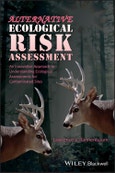In Alternative Ecological Risk Assessment the author, Lawrence V. Tannenbaum, provides a critical review of current practices in the ecological risk assessment field and proposes alternatives that are supported by established science and keen observation. It is hoped that this approach will pave the way to a greater understanding of what appropriate and useful ecological assessment for contaminated sites should entail. He demonstrates that in most cases current practices do not provide for an assessment of ecological risk, and moreover, that endeavoring to assess ecological risk is actually an unnecessary undertaking at conventional hazardous waste sites. (He states, for example, that the concept of scale is often ignored by practitioners, questions why animals like deer are routinely assessed at 5-acre sites, and challenges the ecotoxicology data currently used.)
The book is aimed at students and professionals in the fields of environmental science, ecology, ecotoxicology, and health risk assessment.
Table of Contents
Preface ixAcknowledgments xi
1 An introduction and overview 1
2 Facing the music: understanding what ERA is . . . and is not 14
3 Alternative exposure assessment 28
4 Toxicology and toxicity assessment in ERA revisited 56
5 Risk characterization versus site ecological assessment: Old and new 99
6 Case study: Problem formulation versus making problems for yourself 113
7 Getting beyond ERA 137
8 A new ecological assessment paradigm for historically contaminated sites: Direct health status assessment 160
9 Is RSA the answer to ERA? 179
Index 201








